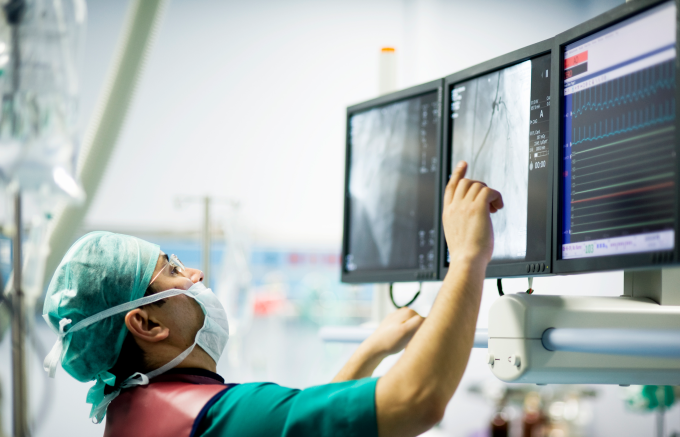Angiogram/Cardiac Catheterization
What you can expect
If an angiogram is in your or your child's future, it’s important to know what to expect before, during, and after the procedure and when you go home to be better prepared for the procedure every step of the way. If you have any questions about the procedure, be sure to ask the doctor ahead of time. But if you’re unsure what to ask, go to the Ask Your Doctor section to print out a list of questions to bring to your or your child's next doctor’s appointment.
Before the angiogram
The doctor will provide instructions to the patient on how to prepare for the angiogram:
- If the patient takes medications such as blood thinners, they should ask the doctor whether they should be stopped before the angiogram. Aspirin should be continued.
- The patient will be asked not to eat or drink anything for several hours before the procedure.
- Tests to measure the patient's blood count, kidney function, and blood-clotting ability may be performed beforehand.
- The patient will receive medications to help relax before the procedure begins.
- If the patient has diabetes, insulin may be temporarily stopped or given at a reduced dosage. Metformin may also be temporarily stopped.
An angiogram requires a visit to a hospital, specifically a specialized room called a catheterization laboratory or “cath lab.” The cath lab contains an X-ray camera and a TV monitor (screen) on which the doctor will view the patient's heart and arteries.
During the angiogram
An angiogram typically takes from 45 minutes to one hour. The steps of the procedure are as follows:
- As the procedure begins, the patient will lie on a table, and a nurse will insert an intravenous line (IV) into a vein in the patient's arm. The IV allows the patient to receive fluids and medications easily. If the patient becomes anxious during the angiogram, additional medications will be given to help the patient relax. The patient will also be mildly sedated but awake throughout the procedure.
- Once the patient is relaxed, the doctor will use a small needle to inject lidocaine, a local anesthetic, to numb an area in the groin (upper leg) or the wrist.
-
This needle prick may be the only pain the patient will feel throughout the procedure, as it’s typically painless. The femoral artery in the groin — near where the leg bends from the hip — is one of the blood vessels doctors most commonly use to insert a catheter (a flexible tube smaller than the vessels) to perform the angiogram. Instead of the femoral artery, the doctor may use the radial artery in the wrist.
- The doctor will thread the catheter through the arteries to the heart from this “access” point in the leg or wrist. Because no nerves are in the arteries, the patient won’t feel the catheter passing through the blood vessels. The X-ray camera helps the doctor guide the catheter to the heart.
- When the catheter is properly positioned, the doctor will inject a contrast dye (radiographic contrast agent) through the catheter into the heart and its arteries. Most patients don’t feel the dye injection; however, some feel minor chest discomfort, typically lasting only a few seconds. A few also feel lightheaded or nauseous.
- When the X-ray beam passes through the dye, the arteries appear in a black silhouette on a white background. If there are any blockages, they appear as white areas. The X-ray camera records a “movie” as a medical digital image of the heart’s pumping chamber and arteries.
- The angiogram provides vital information by enabling the doctor to see blood flow and the size, shape, and length of any blockages in the arteries. However, the doctor may perform other tests to determine the severity of the heart condition, including the degree to which the arteries are narrowed by plaque buildup and whether oxygenated blood is flowing to the heart. These tests, which can provide more information to help guide the patient's treatment options, include the following to assess the significance of the plaque:
- Intravascular ultrasound (IVUS)
- Optical coherence tomography (OCT)
After the angiogram
When the procedure is complete, the doctor will remove the catheter and may use a device to seal the artery puncture site. Otherwise, the doctor or nurse will apply pressure to the entry point on the patient's leg, arm, or wrist and hold it for about 20 minutes.
The patient's wound will then be dressed, and if the catheter was inserted in the leg, the patient will be asked to lie still and avoid bending the leg or lifting the head. The patient may need to be still for two to six hours after removing the catheter.

Post-angiogram home care
Once at home, the patient may notice a bruise in the area where the doctor inserted the catheter, which is caused by blood that has escaped from the vessel under the skin. Since a small — and sometimes larger — bruise is normal, it’s not necessary for the patient to report bruising to the doctor, even if the area is large. Usually, it clears up over one to three weeks. The patient shouldn't lift heavy objects for a week after the angiogram to protect the groin area. And for men, specifically, should sit down to use the bathroom for a week after the angiogram so as not to place pressure on the groin area.
If any of the following issues occur at home, the patient should call the doctor:
- Bleeding, drainage, or painful swelling at the site where the catheter was inserted
- Swelling or weakness and/or numbness in the leg or arm in which the catheter was inserted
Stories of Hope and Recovery

A family history of heart disease was all the reason Gary Lawrence of Gainesville, GA, needed to stay proactive about his heart health. But despite regular visits to his cardiologist and cholesterol-lowering medication, Gary started to notice a decline in his energy levels.
